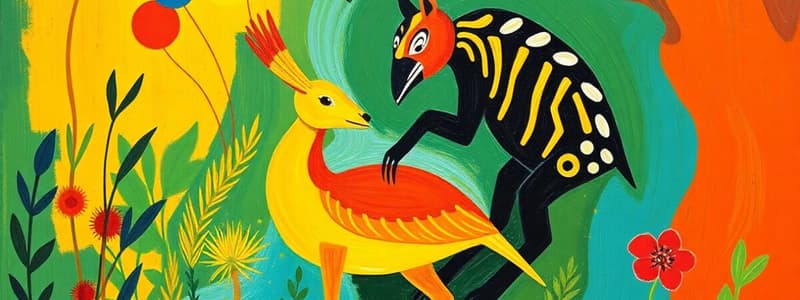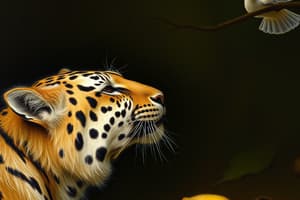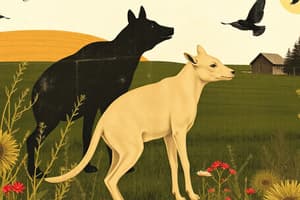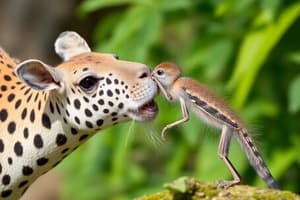Podcast
Questions and Answers
What are the two main types of causation regarding animal behavior?
What are the two main types of causation regarding animal behavior?
- Behavioral and Environmental
- Inherent and Learned
- Proximate and Ultimate (correct)
- Instinctual and Adaptive
Which of the following best describes a Fixed Action Pattern?
Which of the following best describes a Fixed Action Pattern?
- A learned response to a complex stimulus
- An instinctual behavior only seen in mammals
- A habitual response that evolves over time
- A sequence of unlearned acts triggered by a simple stimulus (correct)
Which statement accurately describes the concept of migration in animals?
Which statement accurately describes the concept of migration in animals?
- It is solely based on learned behavior from the parents.
- It involves regular, long-distance movement often influenced by environmental stimuli. (correct)
- It is a random movement pattern in response to internal stimuli.
- It typically occurs only during extreme weather conditions.
What role do pheromones play in animal communication?
What role do pheromones play in animal communication?
What is a characteristic of circannual rhythms in animals?
What is a characteristic of circannual rhythms in animals?
What happens to the immigration rate as species diversity increases?
What happens to the immigration rate as species diversity increases?
What is the primary factor that can lead to an increase in extinction rates?
What is the primary factor that can lead to an increase in extinction rates?
Which of the following correctly describes zoonotic pathogens?
Which of the following correctly describes zoonotic pathogens?
What impact does the size and distance from the mainland have on species immigration and extinction according to the Island Equilibrium Model?
What impact does the size and distance from the mainland have on species immigration and extinction according to the Island Equilibrium Model?
How do pathogens alter community structure?
How do pathogens alter community structure?
What term describes the growth of a plant towards a stimulus such as sunlight?
What term describes the growth of a plant towards a stimulus such as sunlight?
Which type of behavior is specifically characterized by movement towards or away from a stimulus in animals?
Which type of behavior is specifically characterized by movement towards or away from a stimulus in animals?
What aspect of animal behavior focuses on the ecological and evolutionary factors influencing actions?
What aspect of animal behavior focuses on the ecological and evolutionary factors influencing actions?
Which type of behavior is described as genetically controlled and does not require prior experience?
Which type of behavior is described as genetically controlled and does not require prior experience?
Which of the following is not considered a method of communication among animals?
Which of the following is not considered a method of communication among animals?
What is the primary function of communication behaviors among animals?
What is the primary function of communication behaviors among animals?
Which of the following is a benefit of animals cooperating in groups?
Which of the following is a benefit of animals cooperating in groups?
What is the role of discrete sensory inputs in animal behavior?
What is the role of discrete sensory inputs in animal behavior?
What is the primary function of imprinting in young animals?
What is the primary function of imprinting in young animals?
Which form of learning involves modifying behavior based on personal experience?
Which form of learning involves modifying behavior based on personal experience?
What is the optimal foraging model based on?
What is the optimal foraging model based on?
Which mating system is characterized by an individual of one sex mating with several members of the opposite sex?
Which mating system is characterized by an individual of one sex mating with several members of the opposite sex?
In which situation is altruism most likely to occur?
In which situation is altruism most likely to occur?
What is Hamilton's Rule primarily used to analyze?
What is Hamilton's Rule primarily used to analyze?
Which learning type involves observing and mimicking the behavior of others?
Which learning type involves observing and mimicking the behavior of others?
What type of sexual selection occurs when individuals compete for mating opportunities?
What type of sexual selection occurs when individuals compete for mating opportunities?
How does play behavior primarily benefit animals?
How does play behavior primarily benefit animals?
What is the relationship between sexual dimorphism and mating systems?
What is the relationship between sexual dimorphism and mating systems?
What defines a cognitive map in the context of spatial learning?
What defines a cognitive map in the context of spatial learning?
When is the certainty of paternity typically highest?
When is the certainty of paternity typically highest?
What role does genetic predisposition play in behavior?
What role does genetic predisposition play in behavior?
Which type of learning occurs when an organism learns to associate two environmental features?
Which type of learning occurs when an organism learns to associate two environmental features?
What type of behavior is C.elegans displaying when it directs its movement towards a food source it can detect?
What type of behavior is C.elegans displaying when it directs its movement towards a food source it can detect?
How does energy transfer within a food chain typically occur according to the energetic hypothesis?
How does energy transfer within a food chain typically occur according to the energetic hypothesis?
What term describes the organisms that produce their own organic compounds through photosynthesis or chemosynthesis?
What term describes the organisms that produce their own organic compounds through photosynthesis or chemosynthesis?
Which ecological interaction refers to when one species benefits at the expense of another?
Which ecological interaction refers to when one species benefits at the expense of another?
What is the ecological niche of an organism?
What is the ecological niche of an organism?
What is the primary benefit of higher species diversity in a community?
What is the primary benefit of higher species diversity in a community?
Which term describes the hypothetical condition that two species cannot coexist if they occupy identical ecological niches?
Which term describes the hypothetical condition that two species cannot coexist if they occupy identical ecological niches?
What process describes the gradual replacement of species in a given area over time following a disturbance?
What process describes the gradual replacement of species in a given area over time following a disturbance?
What is the term for the area of overlap between two biomes?
What is the term for the area of overlap between two biomes?
What type of organisms are characterized by their inability to regulate body temperature and often exhibit behaviors to adapt to temperature changes?
What type of organisms are characterized by their inability to regulate body temperature and often exhibit behaviors to adapt to temperature changes?
What model suggests that higher trophic levels influence lower ones in an ecosystem?
What model suggests that higher trophic levels influence lower ones in an ecosystem?
What phenomenon refers to the fine, localized patterns of climate conditions?
What phenomenon refers to the fine, localized patterns of climate conditions?
What term describes the process whereby a species moves away from its original habitat to a new location?
What term describes the process whereby a species moves away from its original habitat to a new location?
What is the main characteristic of R-selected species?
What is the main characteristic of R-selected species?
What does the equation dN/dt = B - D represent?
What does the equation dN/dt = B - D represent?
Which growth model shows a slow increase followed by a rapid growth phase but eventually levels off?
Which growth model shows a slow increase followed by a rapid growth phase but eventually levels off?
What does K represent in the logistic growth model dN/dt = rmaxN(K-N)/K?
What does K represent in the logistic growth model dN/dt = rmaxN(K-N)/K?
What type of survivorship curve describes species that have high mortality rates for the young?
What type of survivorship curve describes species that have high mortality rates for the young?
Which of the following best defines ecological footprint?
Which of the following best defines ecological footprint?
What is the primary cause of demographic transition in human populations?
What is the primary cause of demographic transition in human populations?
Which of the following statements about r-selection is accurate?
Which of the following statements about r-selection is accurate?
Which term describes the phenomenon where a loss of genetic diversity increases extinction risk in small populations?
Which term describes the phenomenon where a loss of genetic diversity increases extinction risk in small populations?
What is the significance of a sympathetic relationship in ecology?
What is the significance of a sympathetic relationship in ecology?
Which ecological principle explains how energy is lost at each trophic level?
Which ecological principle explains how energy is lost at each trophic level?
What does the term 'biogeochemical cycles' refer to?
What does the term 'biogeochemical cycles' refer to?
Which of the following concepts involves connecting fragmented ecosystems for better species interaction?
Which of the following concepts involves connecting fragmented ecosystems for better species interaction?
What is the main objective of conservation biology?
What is the main objective of conservation biology?
Flashcards
Stimulus
Stimulus
An external signal that causes a response in an organism. For example, the smell of food could trigger a foraging response.
Tropism
Tropism
Growth towards (positive) or away from (negative) a stimulus. Example: plants bending towards the sun.
Taxis
Taxis
A directed movement of an animal towards or away from a stimulus. Example: moths flying towards a light.
Kinesis
Kinesis
Signup and view all the flashcards
Communication Behaviors
Communication Behaviors
Signup and view all the flashcards
Innate Behavior
Innate Behavior
Signup and view all the flashcards
Learned Behavior
Learned Behavior
Signup and view all the flashcards
Behavioral Ecology
Behavioral Ecology
Signup and view all the flashcards
Fixed Action Pattern
Fixed Action Pattern
Signup and view all the flashcards
Sign Stimulus
Sign Stimulus
Signup and view all the flashcards
Ultimate Causation
Ultimate Causation
Signup and view all the flashcards
Proximate Causation
Proximate Causation
Signup and view all the flashcards
Pheromones
Pheromones
Signup and view all the flashcards
Species Equilibrium
Species Equilibrium
Signup and view all the flashcards
Island Equilibrium Model
Island Equilibrium Model
Signup and view all the flashcards
Population Ecology
Population Ecology
Signup and view all the flashcards
Emigration
Emigration
Signup and view all the flashcards
Pathogens
Pathogens
Signup and view all the flashcards
Learning
Learning
Signup and view all the flashcards
Imprinting
Imprinting
Signup and view all the flashcards
Spatial Learning
Spatial Learning
Signup and view all the flashcards
Cognitive Map
Cognitive Map
Signup and view all the flashcards
Associative Learning
Associative Learning
Signup and view all the flashcards
Classical Conditioning
Classical Conditioning
Signup and view all the flashcards
Operant Conditioning
Operant Conditioning
Signup and view all the flashcards
Cognition
Cognition
Signup and view all the flashcards
Problem Solving
Problem Solving
Signup and view all the flashcards
Social Learning
Social Learning
Signup and view all the flashcards
Culture
Culture
Signup and view all the flashcards
Foraging
Foraging
Signup and view all the flashcards
Optimal Foraging Model
Optimal Foraging Model
Signup and view all the flashcards
Sexual Dimorphism
Sexual Dimorphism
Signup and view all the flashcards
Experimental Group
Experimental Group
Signup and view all the flashcards
Control Group
Control Group
Signup and view all the flashcards
Hypothesis
Hypothesis
Signup and view all the flashcards
Homeostasis
Homeostasis
Signup and view all the flashcards
Endotherms
Endotherms
Signup and view all the flashcards
Ectotherms
Ectotherms
Signup and view all the flashcards
R-selected Species
R-selected Species
Signup and view all the flashcards
K-selected Species
K-selected Species
Signup and view all the flashcards
Trophic Structure
Trophic Structure
Signup and view all the flashcards
Trophic Levels
Trophic Levels
Signup and view all the flashcards
Photosynthesis
Photosynthesis
Signup and view all the flashcards
Chemosynthesis
Chemosynthesis
Signup and view all the flashcards
Heterotrophs
Heterotrophs
Signup and view all the flashcards
Population Growth Equation
Population Growth Equation
Signup and view all the flashcards
Dispersion
Dispersion
Signup and view all the flashcards
Exponential Growth
Exponential Growth
Signup and view all the flashcards
rmax
rmax
Signup and view all the flashcards
Demography
Demography
Signup and view all the flashcards
Life Table
Life Table
Signup and view all the flashcards
Survivorship Curve
Survivorship Curve
Signup and view all the flashcards
Logistic Growth
Logistic Growth
Signup and view all the flashcards
Carrying Capacity (K)
Carrying Capacity (K)
Signup and view all the flashcards
Life History Traits
Life History Traits
Signup and view all the flashcards
Semelparity
Semelparity
Signup and view all the flashcards
Iteroparity
Iteroparity
Signup and view all the flashcards
Study Notes
Organisms and Environment
- Organisms respond to their environment with behaviors and physiological processes
- Stimulus: an external signal causing a response
- Tropism: growth toward (positive) or away from (negative) a stimulus (plants)
- Positive phototropism: growth towards light
- Gravitropism: growth downwards, roots
- Taxis: directional movement toward or away from something (animals)
- Kinesis: random movement related to a stimulus (animals)
- Organisms communicate to benefit survival and reproduction through visual, tactile, audible, electrical, or chemical signals
- Aposematic coloration: warning coloration (poisonous organisms)
- Scent marking for territory or mate attraction
- Animals often cooperate ensuring group survival
- Individuals may take on specific roles in the group
- Innate behavior: genetically determined, without prior knowledge
- Learned behavior: acquired through experience
Learned Behavior
- Behavior: action carried out by muscles under nervous system control
- Essential for animal survival and reproduction
- Subject to natural selection
- Simple and complex behaviors stimulated by sensory inputs
- Niko Tinbergen's questions for understanding behavior
- What stimulus elicits the behavior?
- How does the animal's experience influence behavior?
- How does behavior aid survival and reproduction?
- What is the behavior's evolutionary history?
- Types of Causation
- Proximate: how behavior occurs
- Ultimate: why a behavior occurs
- Fixed Action Pattern (FAP): unlearned, automatic behavioral sequence (e.g., stickleback)
- Sign Stimulus: external cue triggering a behavior
- Migration: regular, long-distance movement
- Behavioral Rhythms
- Circadian Rhythm: daily cycle (sleep-wake)
- Circannual Rhythm: annual cycle (migration)
Learning and Cognition
- Imprinting: long-lasting behavioral response to a particular individual or object, usually in young animals
- Spatial Learning: creating a memory of the spatial environment
- Cognitive Map: mental representation of the surroundings
- Associative Learning: associating one environmental feature with another (classical and operant conditioning)
- Cognition: awareness, reasoning, recollection, and judgment (involves problem-solving)
- Social Learning: learning from observing others
Population Ecology
- Population: group of individuals of the same species inhabiting the same area, interacting and breeding
- Exponential Growth: population increasing at a constant rate in unlimited resources
- Logistic Growth: population growth rate slows as it approaches carrying capacity
- Carrying Capacity (K): maximum population size an environment can sustain
- Population Density: number of individuals per unit area
- Density-dependent factors: birth/death rates vary with density (e.g., food, predators, disease)
- Density-independent factors: birth/death rates remain the same (e.g., natural disasters)
Community Ecology
- Community: group of populations of different species interacting closely enough to affect each other
- Interspecific Interactions: +/- interactions between species
- Exploitation: +/- e.g., predation, herbivory, parasitism
- Competition: -/- e.g., for resources
- Symbiosis: close relationship (+/- or 0) e.g., mutualism, commensalism
- Niche: sum of species' use of biotic and abiotic resources.
- Niche partitioning: similar species coexisting by using resources differently
- Character Displacement: traits diverge more in sympatric than allopatric populations
- Community stability: tendency to reach and maintain a relatively stable composition
- Resilience: the ability to recover from disturbance
Ecosystem Ecology
- Ecosystem: living and nonliving components of an area
- Trophic Levels: feeding relationships in an ecosystem
- Producers, Primary consumers, Secondary consumers, Tertiary consumers
- Energy flow: transfer of energy through trophic levels
- Biomass: total mass of organisms in an area
- Energy pyramid: loss of energy as it moves through trophic levels
- Biogeochemical Cycles: movement of nutrients through ecosystems
- Ecosystems and Biodiversity: factors affecting community diversity
Biodiversity
- Species Richness: Number of different species
- Relative Abundance: proportion of each species in a community
- Species Diversity: combines richness and evenness (relative abundance of species)
- Ecological Disturbances: events that remove or alter resources
- Intermediate Disturbance Hypothesis: intermediate levels of disturbance tend to support higher numbers of species
- Succession: changes in species composition of a community over time (ex: primary and secondary succession)
- Biogeographic Factors: influence ecosystem diversity
- Latitudinal Gradient: diversity increases towards equators
- Species-area curve: the larger the geographic area, the greater the species diversity
- Ecosystem Services: important benefits provided by ecosystems to humans
- Water purification, pollination, nutrient cycling (ex.)
Human Impact
- Biological Magnification: toxins accumulating more at higher trophic levels
- Invasive Species: species introduced to new ecosystems negatively impacting native biodiversity.
Studying That Suits You
Use AI to generate personalized quizzes and flashcards to suit your learning preferences.




